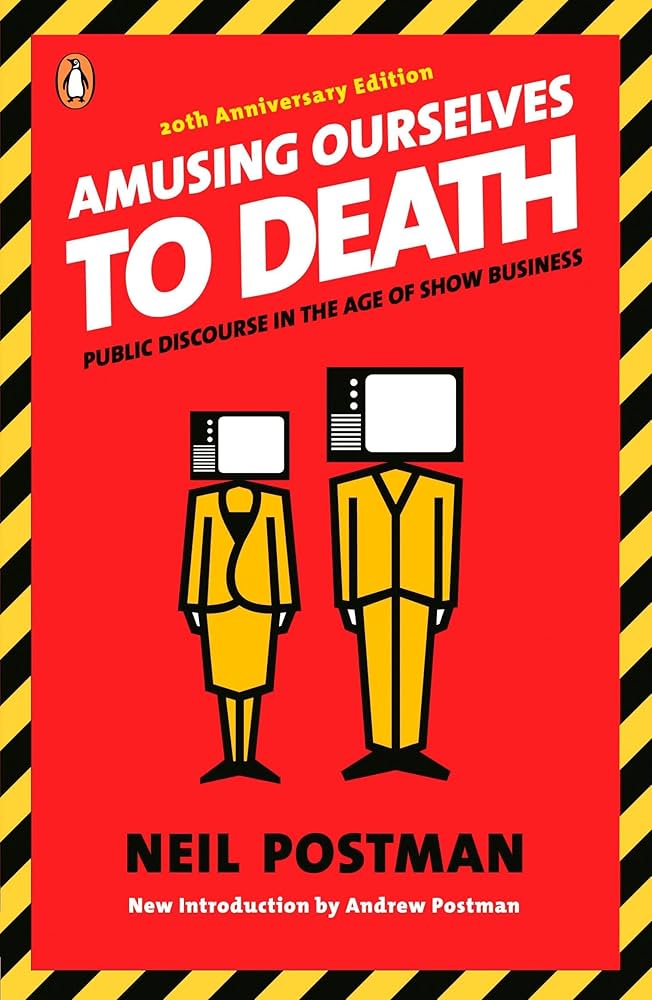This is a copy of my Goodreads review of "Amusing Ourselves to Death" by Neil Postman. I read the book over the summer while I was working at Meta and it was a great read and I highly recommend it espeicially if you're interested in epistemology. 5/5 stars.

My Review
Amusing Ourselves to Death is an amazing book. When I began working at Meta, on the first day we had an orientation where, in a video, Chris Cox, the CPO, explained the philosophy that went behind creating the initial TheFacebook social media. He brought up Marshall McLuhan and his idea of "the media is the message" where the media in which content is described imparts its own beliefs that changes the original message of the content. In regards to Facebook, Chris Cox explained they were very deliberate in how their social media would impart its own message on how users interact with others, creating a network of friends that grows as they interact with each other with no physical bounds like before. Encouraging people to speak (or post) their minds more and meet more people.
He conveniently leaves out the negative messages the Facebook social media imparts on its content (popularity contests, misinformation, oversharing, etc.) but it was a very interesting idea that I wanted to learn more about. I thought about reading Marshall McLuhan immediately, but I settled for a more beginner friendly book in Amusing Ourselves to Death.
Starting with criticisms I suppose. Amusing Ourselves to Death, henceforth called AOD, is a book that is both prophetic and completely incorrect about the future at the same time. At the time of its writing, 1985, the television was the most widespread form of communication with the internet and computers just starting to become popular. Postman takes a strangely disinterested view on the computer media especially how his entire book is about analyzing the effect different forms of media (spoken word, written word, television, etc) has had on society, he leaves only a few sentences analyzing how computers have and could change the information landscape. Although, what he does say about computers he gets absolutely right by describing how data collection will be a major focus for the future of computer interaction. Also, while Postman is a great academic and references great sources throughout the book, he is very clearly opinionated which doesn't bother me personally but I think he was a tad bit too harsh on television in some cases compared to nowadays. If he could only see how our attention spans have degraded now.
Other than those two nitpicks, this book was phenomenal and has changed the way I interact with sources of information around me. There is far more to learn from the nature of how content is delivered than the content itself for the most part and only by understanding how different forms of media tend towards different forms of truth can we truly be informed in today's world.
It's disappointing how many people consider information to be independent of how it's delivered. Postman does not only mean that some sources of information contain more facts than the others, although that is definitely true. He means that our brain interprets information differently from different forms of media. An example he used in the books that has been the focus of many research studies is the difference between getting the news from a newspaper article vs from TV news (although nowadays we mostly get our news from Twitter or some other BS). The newspaper article readers remembered far more about the same news story than the TV news watchers despite both containing the same information. The only difference between the two contents were the media they were presented in. A newspaper article allows for readers to read at their own pace, going back if they are confused and thus easily remembering call backs and citations within the article allowing them greater analytical thinking. On the other hand, TV news must be consumed all at once and you must split your thinking between the words being spoken vs the images being presented. With our dumb monkey brains, images that are easy to see and understand offer more enjoyment than the words being spoken and thus the viewers remember less about the content and perform less thinking. This is why TV news, and frankly print news nowadays, focuses more on the images surrounding the news vs the news itself as they are competing with each other for attention and it is far easier to give attention to cool pictures that you can just throw on at any time than a well informed journalist explaining the historical context behind the latest news. A great example of the media message.
Throughout the book, I just kept thinking of how the internet, social media, and AI has been imparting their own message on their information. However, it is clear not many people are thinking about this with how many people have what Marshall McLuhan calls "rear-view thinking" where people believe old forms of content can simply exist through new forms of media with no changes to the message. People think AI can replace teachers, social media can replace friendships, and existing in general can occur on the internet with no ramifications. It is depressing to think about that most people can barely even read a book nowadays and want to continue this degenerating cycle.
While the world may not be able to be saved, I can help myself escape this garbage by reading more McLuhan, Postman, and about epistemology in general as I greatly enjoyed reading this book.